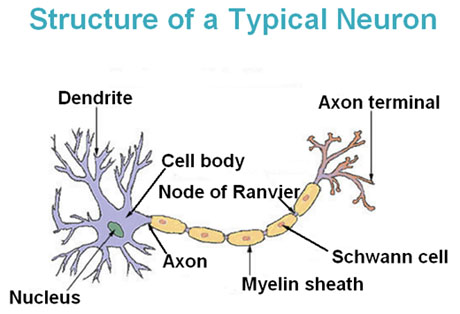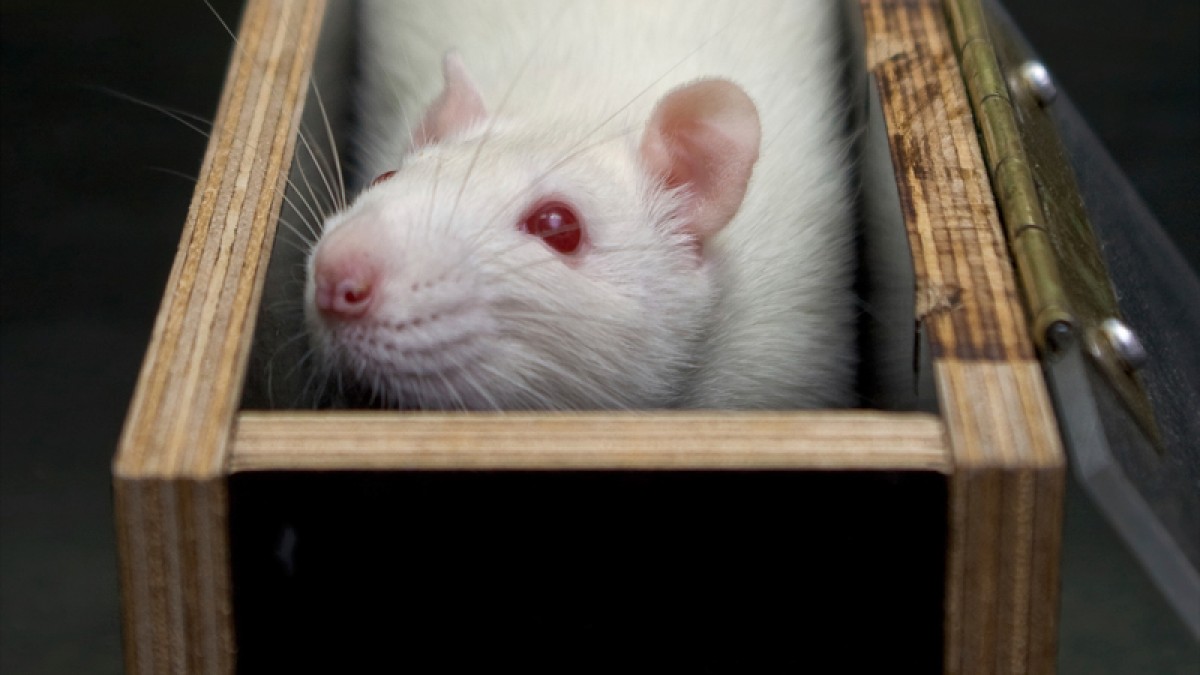Neurotransmission
Nerve cells, called neurons, are one of the building blocks of behaviour. It is estimated that there are between 10 and 100 billion neurons in the nervous system and that neurons make 13 trillion connections with each other. The neurons send electrochemical messages to the brain so that people can respond to stimuli—either from the environment or from internal changes in the body.
The following video explains how neurotransmitters were discovered.
 The process by which these messages are sent is called neurotransmission. The electrical impulse that travels along the body of the neuron is called an action potential. When an action potential travels down the body, or axon, of the neuron, it releases neurotransmitters that are stored in the neuron’s terminal buttons. The neurotransmitters are then released into the gap between the neurons – called the synapse. The synaptic gap is an incredible one-millionth of a centimeter! Neurotransmitters are the body’s natural chemical messengers that transmit information from one neuron to another. After crossing the synapse, the neurotransmitters fit into receptor sites on the post-synaptic membrane, like a key in a lock. Once the message is passed on, the neurotransmitters are either broken down by an enzyme or reabsorbed by the terminal buttons, in a process called reuptake.
The process by which these messages are sent is called neurotransmission. The electrical impulse that travels along the body of the neuron is called an action potential. When an action potential travels down the body, or axon, of the neuron, it releases neurotransmitters that are stored in the neuron’s terminal buttons. The neurotransmitters are then released into the gap between the neurons – called the synapse. The synaptic gap is an incredible one-millionth of a centimeter! Neurotransmitters are the body’s natural chemical messengers that transmit information from one neuron to another. After crossing the synapse, the neurotransmitters fit into receptor sites on the post-synaptic membrane, like a key in a lock. Once the message is passed on, the neurotransmitters are either broken down by an enzyme or reabsorbed by the terminal buttons, in a process called reuptake.
Neurotransmitters have been shown to have a range of different effects on human behaviour. In fact, neurotransmission underlies behaviour as varied as mood, sleep, learning and memory, sexual arousal, and mental illness. The table below, which highlights just a few neurotransmitters, gives an idea of the variety of behaviours that are influenced by these neurochemicals.
Neurotransmitters
| Acetylcholine | Plays a role in the consolidation of memory in the hippocampus. |
| Dopamine | Controls the brains' reward and pleasure centers. Plays a key role in motivation; low levels are linked to addictive behaviour. |
| Norepinephrine | Arousal and alertness. |
| Serotonin | Sleep, arousal levels, and emotion. |
Inhibitory or excitatory?
When discussing neurotransmitters, there are three different types.
- Excitatory neurotransmitters increase the likelihood of a neuron firing by depolarizing the neuron. Excitatory neurotransmitters include acetylcholine.
- Inhibitory neurotransmitters decrease the likelihood of a neuron firing by hyperpolarizing the neuron. Inhibitory neurotransmitters include GABA.
- Metabotropic neurotransmitters only indirectly affect the neuron and are considered neither excitatory or inhibitory. Metabotropic neurotransmitters include serotonin, dopamine, and norepinephrine.
Because neurotransmitters fit tightly into receptor sites, like a key in a lock, drugs have been developed to either simulate the neurotransmitter if there is not enough of a specific neurotransmitter or to block the site if it is excessive. The application of such research has improved the lives of many people.
There has been criticism of reducing the explanation of behaviour to the workings of neurotransmitters alone. It is said to be reductionist. Can a complex human behaviour like falling in love with someone be attributed to a simple “love cocktail” of dopamine and norepinephrine? Can your mood during the summer holidays be attributed simply to serotonin levels? Once again, most psychologists consider that neurotransmitters play a role, but do not rely solely on neurotransmission to explain behaviour.
Research in psychology: Rogers & Kesner (2003)
 Rogers & Kesner conducted an experiment to determine the role of acetylcholine in memory formation. There is a significant number of acetylcholine receptors in the hippocampus.
Rogers & Kesner conducted an experiment to determine the role of acetylcholine in memory formation. There is a significant number of acetylcholine receptors in the hippocampus.
After being injected, the rats were again placed into the maze to see how long it would take them to find the food that they had previously located.
The findings were that the scopolamine group took longer and made more mistakes, whereas the control group learned faster and made fewer mistakes. It appears that acetylcholine may play an important role in memory consolidation.
A more detailed explanation of the study can be found here.
There are many strengths to carrying out an experiment like the one by Rogers and Kesner. First, the procedure is very simple. In this way, the study can be easily replicated and the reliability of the results can be tested. In addition, the experiment was highly controlled. The only difference in the conditions is the level of acetylcholine. To make sure that receiving the injection was not the factor that influenced the rats’ ability to run the maze, the saline solution was injected. In this way, the researchers could rule out the placebo effect as a reason for their results.
However, there are also limitations to the study. It is not clear to what extent we can generalize the findings from rats to human beings. However, researchers have found that there are lower levels of acetylcholine in Alzheimer’s patients.
In a study by Antonova et al (2011), researchers demonstrated that blocking acetylcholine receptors in the brain can affect spatial memory tasks in humans. In their study, they used a sample of twenty healthy male adults, with a mean age of 28 years old. The study used a double-blind procedure and participants were randomly allocated to one of two conditions. They were injected with either Scopolamine or a placebo.
The participants were then put into an fMRI where they were scanned while playing the "Arena task." This is a rather complex virtual reality game in which the researchers are observing how well the participants are able to create spatial memories. The goal is for the participants to navigate around an "arena" with the goal of reaching a pole. After they have learned where the pole is located, the screen would go blank for 30 seconds. During this time, the participants were told to actively rehearse how to get to the pole in the arena. When the arena reappeared, the participant was now at a new starting point in the arena. The participants would have to use their spatial memory to determine how to get to the location of the pole.
The procedure was repeated three to four weeks later, each participant received the other treatment.
The researchers found that when participants were injected with scopolamine, they demonstrated a significant reduction in the activation of the hippocampus compared to when they received a placebo. It appears that acetylcholine could play a key role in the encoding of spatial memories in humans, as well as in rats.
Not all memory formation is excitatory
The most important inhibitory neurotransmitter is GABA - or Gamma-aminobutyric acid. It appears that this neurotransmitter inhibits neural activity both in the hippocampus and in the frontal lobe. This inhibition of neural activity allows us to increase our cognitive load - that is, how we are able to use our working memory. When GABA levels are low, intrusive thoughts may make it difficult for us to concentrate and lay down new memories.
In a study by Porges et al (2017), the researchers looked at GABA concentrations in the frontal lobe in a sample of 94 older adults without a history of dementia. The mean age was 73 years. The participants were asked to take the Montreal Cognitive Assessment to test their cognitive functioning.
The researchers found that there was a correlation between higher concentrations of GABA in the frontal lobe and superior cognitive performance. This is significant because GABA concentrations decrease with age. This research may lead to important treatments for people suffering from dementia. For a modern study of how this treatment might work, see the key study by Prevot et al (2019).
Agonists and antagonists
When discussing the process of neurotransmission, biologists refer to chemicals as agonists or antagonists, depending on what they do the pre- or post-synaptic receptor site.
All neurotransmitters are agonists for receptor sites. They are referred to as endogenous agonists since they are biologically already part of our nervous system. So, acetylcholine is an agonist for ACh receptor sites. Drugs can also be agonists. Since they are external to our system, they are referred to as exogenous agonists. For example, nicotine is an agonist for ACh receptor sites and in the short term appears to have some positive effects on memory. (It should be noted, however, that long-term use of nicotine has a negative effect on memory!)
Antagonists are drugs that block the receptor site and do not allow the neurotransmitter to do its job, so no action potential is sent down the neuron. For example, scopolamine is an antagonist for ACh.
For IB exams starting in 2020, you may be asked an SAQ on either agonists or antagonists. The study by Rogers and Kesner can be used to answer both questions. Can you see why?
Checking for understanding
What happens to the neurotransmitters after they are released into the synapse?
Looking at the list of neurotransmitters in this chapter, which ones do you think are involved in falling in love?
Fischer has found that all three of these neurotransmitters play a role in love. In fact, she calls it the "love cocktail." If you think about, motivation, mood and being alert are all part of falling in love.
Research by Rogers & Kesner supported the theory that acetylcholine plays a role in
The study found that acetylcholine plays a role in the transfer of information from short-term to long-term memory. There are many acetylcholine receptors in the hippocampus, so this makes a lot of sense.
What was the control condition in the study by Rogers and Kesner?
The injection with a saline solution served as a control. In this way, they could rule out the placebo effect.

 IB Docs (2) Team
IB Docs (2) Team
